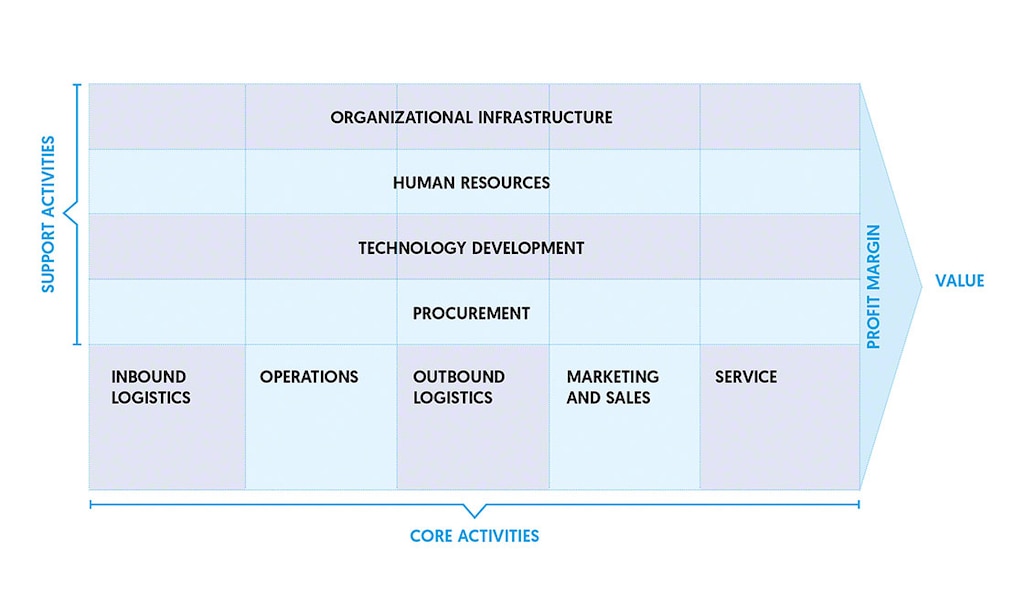
Logistics value chain: what is it?
The value chain is a theoretical model developed by US economist Michael Porter in 1985 that helps to identify competitive advantages in business strategies. Harvard Business School’s Institute for Strategy and Competitiveness defines the concept of a value chain as “a powerful tool for disaggregating a company into its strategically relevant activities in order to focus on the sources of competitive advantage, that is, the specific activities that result in higher prices or lower costs.” The logistics value chain consists of the set of activities performed inside and outside the warehouse that add value to a product or service, giving an organization a competitive advantage over its rivals.
In his book The Competitive Advantage, Porter divides the stages of the value chain into core and support activities, with logistics carrying substantial weight in all phases. These are the five core activities:
- Inbound logistics: goods receipt, storage, inventory control (raw and/or other materials the company receives), and supplier relationships.
- Operations: the procedures required to transform the inbound materials into finished products.
- Outbound logistics: activities relating to product distribution, e.g., storage, order shipping, management of transportation routes, and delivery to end customers.
- Marketing and sales: the set of strategies geared towards promoting brand visibility and attracting potential customers. The aim of this core activity is to convince consumers to purchase the business’s products or services.
- Service: procedures designed to improve the customer experience in the purchasing, returns, maintenance, and service phases.
In addition to defining the main activities of the value chain, Porter details the support functions that raise the value of the final product. For example, in a business organization, factors such as technology development and human resource management enhance the quality of a product or service.

Importance of the logistics value chain
Logistics plays an essential role in Porter’s value chain model. Proper management of inbound and outbound logistics ensures a constant flow of raw materials to the production lines, efficient inventory management, and agile, error-free order distribution.
Porter’s framework defines inbound logistics as operations such as the procurement of products and raw materials, goods receipt, stock identification, and putaway. Outbound logistics, meanwhile, includes the processes involved in delivering finished products, such as order picking, consolidation, and shipment, and the management of final delivery routes. Any error in either inbound or outbound logistics could result in bad service.
How to perform a logistics value chain analysis
Analyzing your logistics value chain enables you to identify cost overruns and competitive advantages in stages such as warehousing, order picking, and goods distribution. A good performance review of your logistics processes starts with these three steps:
- Identify the subactivities in your inbound and outbound logistics operations. The first step is to segment the operations taking place in your facility, reviewing internal processes and predetermined strategies. The purpose of this stage is to understand how each of your warehouse procedures works and how many resources are allocated to their operation.
- Analyze the value and costs of each activity. This second step closely examines the processes involved in inbound and outbound logistics to determine which bring value or give you a competitive edge.
- Define a strategy to increase the value of the product or service. This process will give you a comprehensive overview of how your inbound and outbound logistics operations work. Using the data you’ve gathered, you’ll be able to design a strategy that raises the value of the product or service, optimizes resources, and fosters greater profitability for your company.
Carrying out a value chain analysis makes it easier to detect areas for improvement as well as processes that could create a competitive advantage in storage, order picking, and distribution activities. You can use the results to optimize processes and make decisions supported by reliable, accurate information, thus improving business performance.

Digitalization to optimize the logistics value chain
Digitalizing your logistics operations boosts business performance. “Before the advent of modern information technology, products were mechanical, and activities in the value chain were performed using manual, paper processes and verbal communication,” says Porter in an article published in Harvard Business Review. “The first wave of IT, during the 1960s and 1970s, automated individual activities in the value chain, from order processing and bill paying to computer-aided design and manufacturing resource planning.”
According to Porter, information technologies marked a before and after in the value chain. “The productivity of activities dramatically increased, in part because huge amounts of new data could be captured and analyzed in each activity.” Emerging technologies pave the way for greater integration between the different business areas of a company. Advanced software such as enterprise resource planning (ERP) programs and warehouse management systems (WMSs) simplify the identification of inefficiencies in operational performance. Digital systems automate the recording of information and enable visibility of activities along the value chain.
Replacing manual warehouse management with digitalized control ensures continuous monitoring of logistics value chain activities. Company executives and the different area managers have more information available to them when making business decisions, improving the effectiveness of all processes. The end result is improved product manufacturing and higher-quality services.
Logistics value chain for an efficient organization
Logistics plays a fundamental role in the value chain. Stages such as goods receipt, storage, and transportation route management are key for smooth logistics operations. Moreover, they can be assets for your company’s competitiveness. Errors in these phases, on the other hand, can stunt business growth and prevent products from being delivered under the conditions agreed upon with customers.
Logistics value chain analysis allows you to detect inefficiencies in this area and subsequently optimize your resources. And through warehouse digitalization, you’ll be able to collect data on the performance of each activity, facilitating a real-time analysis of your facility’s operations.
